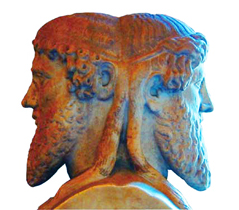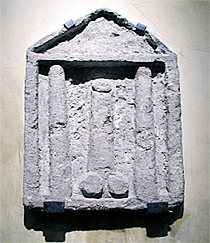 1
1Entrance symbolism – Janus, Doors and Thresholds
The concept of the house as sanctuary began at the entrance. The threshold of the house or villa held a particular significance for the Romans who protected it by associating it with Janus, one of the most ancient of all the Roman gods (fig.1). Those who entered and departed were conscious of this fact and in some cases acknowledged his presence through ritual incantations or gestures. As the god of entrances and exits he is normally characterised by two opposing faces.
Protecting the threshold had a particular significance in Roman society, because the main door onto the street was left open during the day in order to demonstrate family piety. Even thresholds within the house were considered to be ominous places, consequently apotropaic or auspicious symbols were often located near them. In addition to door attachments, these took a variety of forms such as threshold mosaics depicting guard dogs, and wall carvings of phalli (fig.3-5). The Roman obsession with door symbolism is reflected in the numerous examples of door motifs in wall-paintings, many of which are cited in this publication.
Fauces
The short corridor immediately beyond the main door to the house is generally referred to as the fauces (literally meaning the throat of the house). In addition to the threshold, it too contained apotropaic or protective imagery intended to ward off evil. The most famous of these is the CAVE CANEM (beware of the dog) mosaic, located on the floor of the fauces leading into the House of the Tragic Poet (fig.6). Similar guard dog images were also painted onto entrance walls and their presence left visitors in no doubt that the house was a space not to be violated. In addition to protective images the fauces also contained motifs depicting a range of auspicious narratives relating to safe arrival, physical protection and spiritual prosperity. For example, floor mosaics depicting anchors acted as metaphors for safe arrival (safe anchorage fig.7), whilst the presence of divinities, such as the fertility god Priapus, blessed the house and its occupants.
 1
1 4
4
|